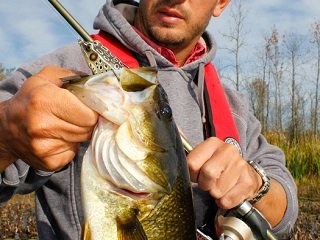 There are a handful of lures that every angler should have on hand at all times. One such lure is the topwater frog. Without a doubt, the topwater frog is one of the finest lures made for drawing bass out of heavy cover. As effective as this lure is in weeds and heavy cover, however, an angler who only throws it in those situations will miss out on opportunities to catch fish with it on open water. Here are a few tips on using a topwater frog on open water to catch big fish.
There are a handful of lures that every angler should have on hand at all times. One such lure is the topwater frog. Without a doubt, the topwater frog is one of the finest lures made for drawing bass out of heavy cover. As effective as this lure is in weeds and heavy cover, however, an angler who only throws it in those situations will miss out on opportunities to catch fish with it on open water. Here are a few tips on using a topwater frog on open water to catch big fish.
Much like using a Zara spook or a popper, the key to fishing a frog on open water is the retrieve. Here, the walk-the-dog technique is ideal, but you have to be sure to move forward no more than a few inches at a time. Anyone who’s used this tactic before will tell you how critical it is to let the lure have just enough slack line to glide sideways, and then turn the opposite direction on the next twitch. When done correctly, each cast should take over a minute to complete. It takes rhythm and time if you’ve never done it before, but once you get it down, the technique is deadly.
The spawn is where casting a frog on open water can really yield rewards. Shallow warming water is great for sight fishing, but spring storms can muddy the clarity and make sight fishing nearly impossible. The noise created by a topwater frog when it’s fished on this open, shallow water can take away any fear of the limited visibility. Start by pitching the frog past the bedding fish, then use the walk-the-dog tactic. Fish on the beds will crush the frog when it intrudes on their territory.
Strong tackle will be your best friend when using a frog, so you’ll need gear that is capable of handling heavy line and cover. Heavy action rods that range from 6’6″ to 7’6″ are ideal, and super lines are must-have. The large hooks of topwater frogs, combined with the bony mouths of large bass, need the low stretch power of braided line. Furthermore, it also aids in fighting and landing fish around stumps, rocks, branches, docks, and other objects. When choosing a color for your frog, I go with white, black, or charteuse. Most frog species have white or grey bellies, which makes a white topwater frog very effective. In low light conditions, a black frog casts a strong silhouette, and a chartreuse one is great on days when the fish just want something different.
One of the marks of true imagination is taking something that’s typically used a certain way and using it with great effectiveness in a different way. Topwater frogs, conventionally used for lily pads and thick cover, can be used on open water to pull in fish. The trick is knowing how to change your tactics to do so. Hopefully, the tips outlined above will help broaden your topwater skill set and add versatility to your fishing the next time you hit the water.








